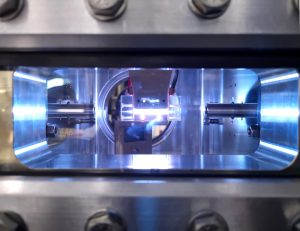 SPARC_LAB (Sources for Plasma Accelerators and Radiation Compton with Laser And Beam) facility at LNF consists in conventional high brightness RF photo-injector, SPARC, as an electron accelerator and a multi-hundred terawatt laser, FLAME, merging the potentialities of the former projects SPARC and PLASMONX.
SPARC_LAB (Sources for Plasma Accelerators and Radiation Compton with Laser And Beam) facility at LNF consists in conventional high brightness RF photo-injector, SPARC, as an electron accelerator and a multi-hundred terawatt laser, FLAME, merging the potentialities of the former projects SPARC and PLASMONX.
The SPARC photoinjector can produce and accelerate high brightness electron beams up to 170 MeV or about 100 MeV, when the beam is compressed to a tenth of picoseconds (10-13s). This beam can feed a 12 m long undulator for FEL generation between 800 nm (infrared) and 40 nm (UV). A tunable and high intense THz source can be also available for advanced longitudinal beam diagnostics and novel user experiments. More recently, we are focusing our studies and experiments on plasma accelerators, that should improve the current acceleration gradient of 2-3 orders of magnitude.
The FLAME laser produces infrared laser pulses at 800 nm carrying 5 J of energy, compressed down to 25 femtoseconds (25 · 10-15s) pulse length. The ultra-intense laser pulses are employed to study the interaction with matter for many purposes: electron acceleration through LWFA, ion and proton beam generation exploiting the TNSA mechanism, study of new radiation sources and development of new electron diagnostics, and can be linked to the linac, i.e. in a Thomson back-scattering experiment, to generate a quasi-coherent, monochromatic X-ray radiation or for laser-plasma based acceleration of the linac electrons.
SPARC_LAB is also involved in many international projects, such as EuPRAXIA and CompactLight.
 INFN-LNF Laboratori Nazionali di Frascati
INFN-LNF Laboratori Nazionali di Frascati